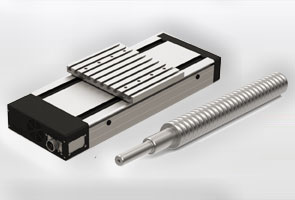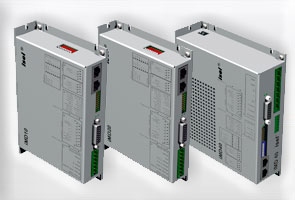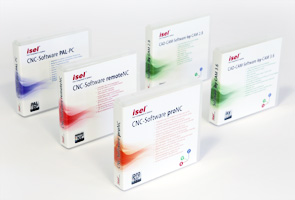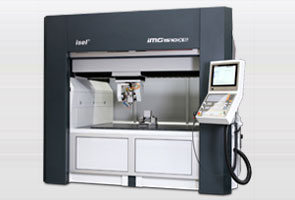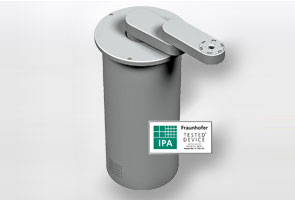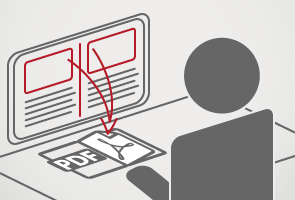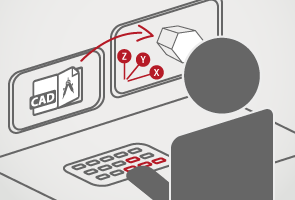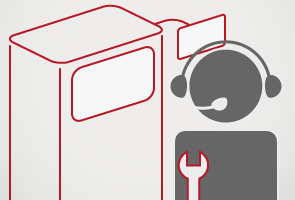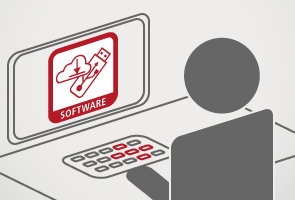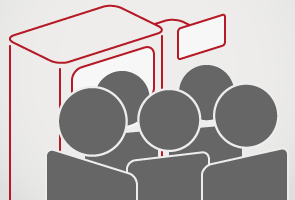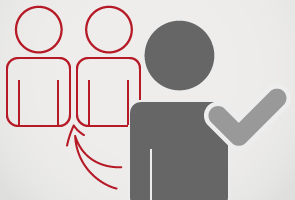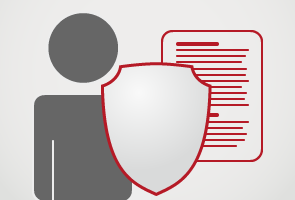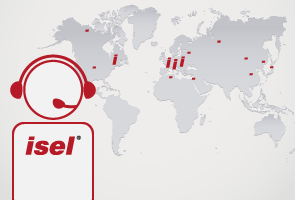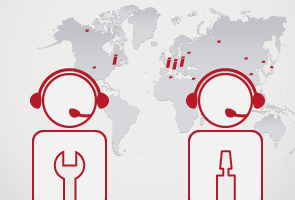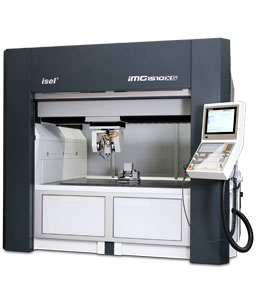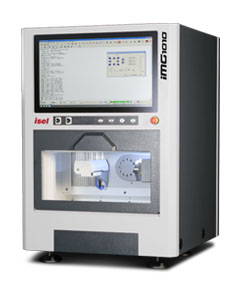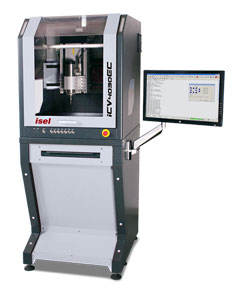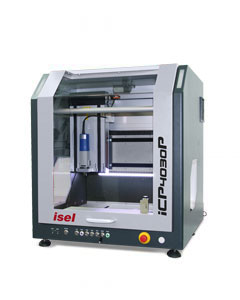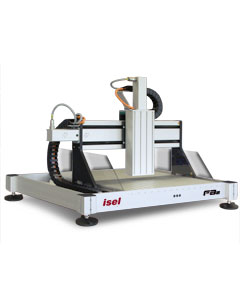isel CNC milling machines: The right system for every application
From the entry-level machine to the complex CNC machine, we offer our customers efficient CNC systems with maximum performance. Every series and every model can be modified as a special machine. Take us at our word!
Premium CNC milling machines: precision machines for microbe processing
Rack machines: High running stability thanks to innovative CAN servo-control
Table machines: CNC entry-level machines in industrial condition
CNC machines from isel: 50 years full service CNC solutions - German machines
Whether it is medical technology, automotive industry, optics or dosing technology: isel CNC customers receive a comprehensive carefree package. Individual advice, a fast, competent isel-own hotline, detailed training, prompt support via Netviewer and a simple user interface thanks to modern CAD/CAM systems are self-evident for us. We are also happy to produce a free production sample including video recording of the processing.
Innovation made by isel: We make visions a reality
isel CNC milling machines: The right system for every application
From the entry-level machine to the complex CNC machine, we offer our customers efficient CNC systems with maximum performance. Each series and model can be modified as a special machine. Take us at our word!
The most important questions about CNC machines: Our specialists answer …
For a host of complex applications, isel has developed a system partner network with specialists for orthopaedic technology, laser technology, dosing technology, plasma technology, 3D printing and many other applications. If your question is not answered in our FAQs, please feel free to ask us personally.
CNC systems in general
1. What is a CNC machine?
A CNC machine is a computer-controlled machine tool, which uses modern control technology to carry out all work processes automatically and precisely and achieve high unit numbers. Its main components are control, software and built-in mechanics.
2. How are CNC machines powered?
The drive elements of CNC machines differ according to the type of application. Depending on the requirements, they are either driven by stepping motors or maintenance-free servo-motors, with step motors generally being used in simple applications and servo-motors in more demanding processes. The latest CNC machines are now also powered by linear motors.
3. In what areas are CNC machines used?
Modern CNC systems are now used as a machine tool in almost all areas of industrial production. The best-known applications include milling, dosing, laser welding, engraving, plasma cutting, gripping and 3D printing. Depending on the requirements, they can process a host of materials including aluminium, brass, plastic, bronze or steel.
4. What are the features of a good CNC machine?
CNC machines are complex systems, which can be completely different depending on the requirements. However, there are some features that characterise a good CNC system. These include process reliability, high geometric accuracy and dynamics, innovative operability, traversing speed, expandability and open interfaces. To avoid machine downtimes, you should also ensure there is comprehensive service.
5. Can you build CNC machines yourself?
The isel system is based on the modular principle, so it is quite possible to create a machine by yourself. Engineering firms and OEM machine builders use this opportunity to create their own designs quickly and easily. In the new Online-Shop, individual components and various machine accessories such as spindles, milling motors and suction devices can be ordered securely and without any hassle.
6. What is the difference between CNC and NC machines?
NC machines were controlled via punch cards and are to a certain extent the predecessors of CNC machines. They are now very old and are no longer used.
7. How did CNC machines come about?
As already mentioned, CNC machines were created from NC machines controlled by punched cards. The American John Parsons, who laid the basis for modern CNC technology at the Massachusetts Institute of Technology in Cambridge, USA, from 1949 to 1952 was a pioneer here. The American company Bendix developed the first NC machine with over 300 electron tubes based on Parson's technology. Controlled by punch cards, the individual work-piece carriers were pushed back and forth by separate motors. This process was referred to as the NC programme.
In Europe, the first NC machine was introduced in 1959, the tool change was automated in 1965, in 1968 the first NC machine with an integrated circuit conquered the market. 1978, saw the transition to the first CNC machine took place. In 1979, the first machines were connected to the CAD system.
Up to the middle of the nineties, the CNC programmes required were hand-written. A tedious task for the programmer, after all, even minimal programme errors could cause serious damage to the CNC machine. From the end of the 90s, programming was done directly from a CAD/CAM system.
8. What is the largest CNC machine in the world?
The largest international CNC machine to date is located at the Tosto factory in the Italian city of Ortona. The gigantic CNC milling machine is over 50 m long, 22 m wide and around 18 m high. At a proud weight of 1,300 tonnes, it weighs as much as seven adult blue whales.
CNC machines in everyday industrial settings
9. What accessories go with a CNC machine?
A CNC machine will be configured differently depending on the requirements, so no general statement can be made here. CNC machines are nowadays no longer on their own, so they should basically be open to other systems. These include, for example, loading and unloading systems, robots or other handling systems. A connection to a higher-level software system in the sense of industry 4.0 is also recommended. However, the most important "machine accessory" is still good maintenance.
10. How many axes are there on a CNC machine?
A general statement is also difficult here, since the number of axes or even the number of modules depends on the respective requirements. A distinction is made between feed and machining axes. The more complex the control system, the more axles usually go with the CNC machine. For industrial milling processes, for example, CNC systems with 5-6 axes are common. The largest CNC machine ever delivered by isel had 21 axes.
11. What types of controls are available?
A CNC tool machine is controlled by a computer directly built into the control. This compares the actual state with the target point state by means of position, rotation and status sensors, directly engages the control system from the CNC program and optimises this as required. The CNC control is classified according to the number of axes and is further distinguished by point control, linear control and path control.
12. What is point control?
In the case of point control or even point-to-point control, the end point of a movement which is approached by the CNC machine tool in the fastest way is determined. The movement speed can not be accessed during the movement itself, the drive elements run as fast as possible. The tool movement can only be modified at the end points. The point control is therefore hardly used in modern machine tools because of its low control options.
13. What is linear control?
Linear control to a certain extent is extended point control, in which the movement speed can also be changed. Even linear control is hardly used in industrial production since speed and position can only be controlled with one axis. Compared to path control, linear control is thus considerably more inflexible.
14. What is path control?
Traversing movements with a minimum of two simultaneously controlled CNC axes can be implemented with path control. The initially separate movement sequences of the individual axes are synchronised with each other, with the result that the tool follows the programmed and optimised path as precisely as possible. In lathes, a 2-D-path control is usually sufficient, the third dimension is produced by the rotary movement of the work-piece. As soon as three controlled axes can be synchronised with each other, we then have 3 D-path control. This is now the control standard in milling.
15. How high is the average machine throughput of CNC machines?
The average machine throughput depends on the application and type of motor. Spindle motors cover around 0.2 m per second, while linear motors already hit 2-3 m per second. Spindle motors are usually completely sufficient for the optimum machine throughput of a CNC milling machine.
16. What is the control circuit of CNC machines?
A closed control circuit is the basic prerequisite for measuring the efficiency of a CNC machine, that is, comparing the actual state with a target point state using a servo-controller. If the control circuit is not closed, the PC does not receive any feedback, possible deviations from the target state remain unrecognised. Almost all CNC machines used for complex industrial processes now contain a closed control circuit.
17. Risk assessment?
The production of CNC systems is subject to fundamental and special safety requirements, which must be fulfilled by the machine manufacturer. These criteria are defined by EU directives, especially by the machinery directive (2006/42 / EC) for mechanical engineering and may vary depending on the application and type of machine. To check the specifications, a risk assessment is carried out during the construction process. The risk assessment first carries out a risk analysis and risk assessment of all hazards. Then the hazards are evaluated. The resulting constructive, control specific or instructive measures incorporated into the design and production process. The risk assessment is the basis for the so-called CE conformity evaluation process, which all machines undergo and which ends with the issuing of a declaration of conformity / incorporation and the affixing of the CE mark to the machine.
18. What is a portal milling machine?
A portal milling machine is a cutter whose milling head is guided on a connecting member between two posts. The frame produced in this way resembles a portal, hence the term portal milling machine. In industry, portal milling machines are usually used for machining large surfaces, for example, when face milling large panels. In many cases, portal milling machines have two additional milling heads on the cross beam, in addition to the milling head on the columns, so that the sides of the work-pieces can also be modified simultaneously in one machine run. Smaller portal milling machines with step motors are often used as engraving machines, for surface processing, for dosing applications or for plasma cutting. With a travel distance of up to approx. 1500 x 1000 x 200 mm, a portal milling machine can also be used in a mobile manner.
19. What is a router?
A router is used in the machining of wood, aluminium and other materials. As the term in German "top cutter" suggests, the router is set on the work-pieces from above. It is suitable for chamfering, profiling and milling of grooves. It is also used for free-hand milling and stencil milling. Depending on the application, different cutters are used, for example groove cutters for the production of rectangular grooves or rounding cutters for rounding edges.
20. What is zero shift?
A zero shift allows the multiple use of milling or drilling samples in one single clamping. For example, 40 parts can be machined in one operation. The production process is significantly more effective using a zero shift, the machine throughput increases.
21. How accurately do CNC machines work?
The most important measured values of a CNC system are positioning and repeatability. These are usually measured by an incremental encoder and are ± 50 μ for the positioning accuracy and ± 20 μ for the repeatability.
22. What do CNC machines cost?
Depending on the application, the cost of CNC machines can range from €5,000 to €150,000.
23. How high is the energy consumption of a CNC cutter and CNC machine?
The energy consumption is always dependent on the machine size and the application. Important parameters for optimising energy consumption are:
- The right machine in terms of size, performance and degree of automation
- Appropriate disconnection and activation of the auxiliary drives
- Consumption-optimised parameterisation of the axis parameters (acceleration, deceleration)
- Automatic shut-down when not in use
- Consumption-optimised programming.
24. How do you programme a CNC machine?
CNC machines are either programmed using modern CAD/CAM systems, directly on the machine or in accordance with Din ISO 66025. The most modern and efficient method is programming via CAD/CAM.
25. Are there CNC systems with cameras?
Usually, a camera does is not part of the basic equipment of a CNC machine, but can be implemented if necessary. However, some industrial applications require a vision system to monitor process machining with the result that the CNC machine is equipped with a camera during manufacture.
26. How does the data transfer from the PC to the CNC machine work?
At the company isel, data transfer is done using modern CAN-BUS technology, which allows easy upgrading of the CNC system and fast reaction times.
27. What is the EVA principle?
The abbreviation "EVA" stands for the entire working process of a CNC machine, i.e. the input using software, electronic processing and output via a post-processor, which converts the transferred data into individual working steps.
Maintenance & transport of CNC machines
28. What is the service life of modern CNC machines?
As with many other aspects, no general statement can be made here, since the service life depends on the type of application and the associated load. The weakest link in the "life of a CNC machine" is, however, in most cases the electronics rather than the mechanics.
29. Is there a maintenance plan for CNC machines?
The maintenance plan is part of the operating instructions. It lists the individual components to be maintained. The most important parameter for the maintenance of CNC machines and cutters is the operating hours. These are generally determined by an operating hour counter, which is geared to the respective machine load. The higher the load, the lower the number of operating hours, after which maintenance is required. Once the set number of operating hours has been reached, a maintenance window will open, indicating the necessary maintenance.
30. How are CNC machines structured?
CNC systems are normally delivered completely assembled by truck and pushed into the production hall in the finished state. It is only difficult with international deliveries or very large machines, which will not fit through the factory gate because of their volume. Here, isel CNC machines have one obvious benefit, for compared to many competitors, they can be completely disassembled and their aluminium honeycomb construction makes them suitable even for transport and construction on non-industrial floors. This even facilitated a delivery to a high-rise building: the machine was delivered disassembled and transported upwards using a lift.
31. How do you clean CNC systems?
CNC milling machines can be equipped with a suction device, which sucks the chips that are generated in aluminium processing, plastic processing or other processes in engineering during production. Alternatively, the coarse soiling can be drawn off, if required, in between or after the end of the production process using an industrial cleaner.
32. CE declaration for robot connection
For a robot connection, a new CE conformity must be created by the manufacturer of the complete system. The CE declaration of the isel CNC machine is included for this purpose. The isel CNC machines are already prepared for robot integration.
33. Disposal at the end of use, disassembly
After the end of use, valuable raw materials are available that can be processed for recycling. For this purpose a CNC machine must be professionally disposed. Nowadays, there are many specialized companies for the proper disposal of CNC machines. We will be happy to provide you with more information. The electrical and electronic components belonging to the machine as well as the operating materials contained in the machine for the production of the operational readiness are to be disposed of exclusively professionally, in accordance with the valid jurisdiction of the operating country.
34. Withdrawal
Depending on the condition of the machine after use, a possibility of return is also offered. We recondition the machines and offer these machines on our used cnc-machines website.


